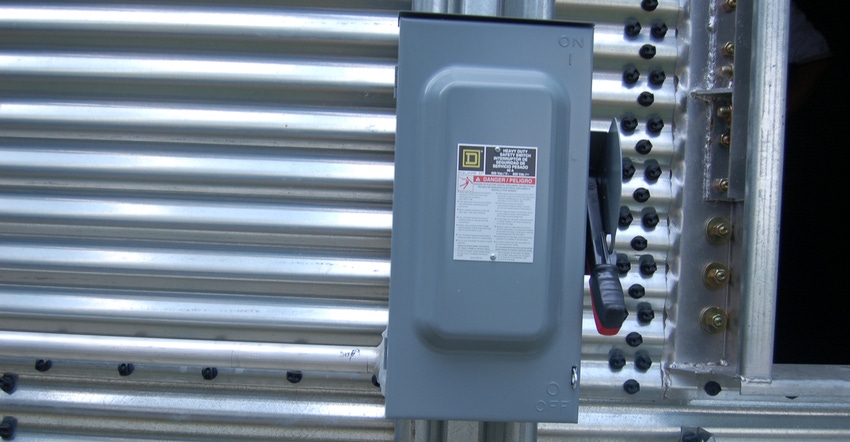
If you store grain on the farm, 2019 may be the unwanted gift that keeps on giving. You could be battling spoilage issues, including plugged bins that won’t unload. Grain that came out of the field wetter than normal with extra fines has already caused problems on many farms. Farm Progress asked two industry experts to address this issue.
They are John Hanig, in charge of bin sales for Sukup, Sheffield, Iowa, and Gary Woodruff, a grain conditioning expert and district manager for GSI, headquartered in Illinois. Both emphasize using extreme caution with plugged bins. Otherwise, you could damage the bin. More importantly, you could risk injury or death to yourself, family members or employees.
If you have a bin that is plugged now, what steps should you take, with safety in mind, to address the situation?
Hanig: First, I would climb to the top and observe the situation by looking through the manhole to see if I can determine the cause. Do not enter the bin.
Woodruff: You should first try to determine the type and extent of the problem. Remember, zero entry should always be the goal. Opening and shutting the gate repeatedly may get grain moving. If not, turn on the aeration fan, and at the manhole, check to see if there are off odors. No odors may indicate a plug caused by excessive fines and debris blocking the center well. If there are mold odors, take additional precautions.
Are there any universal remedies or things to try first?
Hanig: It is possible to open intermediate sumps. There is a highly likely chance that the result of this is it may pull the sidewall of the bin in. If this begins to happen, you must stop immediately.
Woodruff: No, each situation may require different actions. With today’s large bins, at this point it’s probably advisable to call in a professional grain handling dealership to investigate and advise on what the next actions should be. They may have equipment that will allow safe removal of the grain. That may be a rented vacuum system to remove grain from the top.
What are things you would definitely not want to do with regards to being too dangerous?
Hanig: Do not enter the bin with any device to poke down to the center sump. Never enter the bin with unloading equipment running. This is what is depicted in the movie “Silo” that we were involved in. (Editor’s note: The movie is inspired by real events and depicts entrapment in flowing grain. Sukup cooperated with movie producers to ensure as much accuracy as possible. It’s the first full-length movie about grain bin entrapment. Learn more at silothefilm.com.)
Woodruff: Do not open auxiliary wells to pull grain out away from the center of the bin. This can cause extraordinary pressures inward on the sidewall, causing severe damage and structural issues. This becomes increasingly more likely the larger the bin.
Also, do not enter the bin. There may be cavitation voids that you can fall into and become engulfed. Don’t enter the bin and poke grain from the top. It will not likely work. Often, all that’s accomplished is poking holes in the floor, causing damage.
Don’t enter the bin or try to break loose any standing wall of grain. Once it breaks loose, it flows like liquid, and can knock you down and bury you farther away than the grain wall is tall.
There are seldom any quick or easy fixes. It’s not a good time to experiment or try something potentially dangerous.
If it’s absolutely necessary to enter a bin, what safety precautions should you take?
Hanig: All power sources must be locked out and tagged. Whoever is going to enter the bin must have a safety harness on and tied off to the top of the sidewall next to the ladder. There must be a second person on the outside next to the manhole as an observer. A third person should be on the ground within eyesight of the person observing.
Woodruff: First, it’s not advised to enter the bin, as it’s very dangerous, even with special training and equipment. There are recommendations from ag universities on safety equipment, including tag and lockout systems, harnesses, rope tieoffs, breathing masks and equipment, along with extra people on hand to be safer — but it will never be safe for the average person.
If spoiled grain is involved, should you wear a mask? If so, what type?
Hanig: Absolutely. Check with the supplier to see if the mask is adequate for molds. You might possibly even need a respirator. A properly fitted N95 respirator offers protection against mold inhalation.
Woodruff: Absolutely. At the minimum, a paper mask which covers the nose and mouth, rated on the packaging to be good for mold, should always be used if you’re anywhere near the bin or exposed to dust. There are more expensive masks with separate filters and headgear. There is never a time when it is safe to enter a bin, even when empty, due to respiratory threats that mold and dust create.
Once you can finally begin emptying the bin, how should you manage it during the rest of the season?
Hanig: The best scenario would be to completely empty the bin. The grain can usually be put back in or into another bin. Proper aeration must be followed.
Woodruff: In today’s large bins, the only real fix is to remove grain that has become compromised. If you are reasonably sure that you have all out-of-condition grain out of the bin, you could hold the rest. Careful weekly monitoring will be required to make sure the problem doesn’t rekindle.
About the Author(s)
You May Also Like




